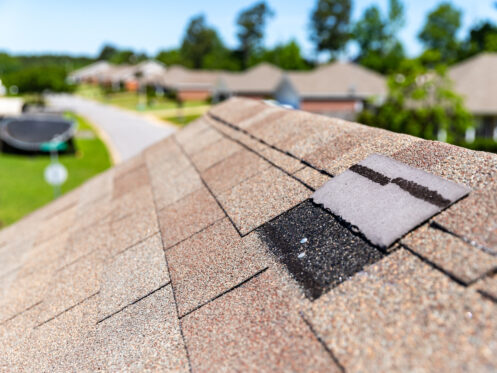When it comes to the lifespan of a roof, homeowners often wonder how long it can really last. While roofs don’t have an indefinite lifespan, the typical expectancy hovers around 20 years. The quality of installation workmanship is crucial, as a poorly installed roof can significantly reduce its lifespan. The choice of roofing materials is also paramount, as cheaper options may require more frequent replacements compared to superior, albeit more expensive, materials. By considering these factors carefully, homeowners can make informed decisions that promote longer-lasting roofs for their homes. The different types of roofs we address all have different lifespans and need regular maintenance and inspection to live up to their full potential.
Asphalt Shingle Roofs
Generally, the majority of newer homes will have an asphalt shingle roof. Asphalt shingles have earned their reputation as the most popular roofing material in the United States, thanks to their affordability, durability, and impressive warranties that can extend up to 25 years. These shingles have a combination of fiberglass and asphalt sealant, creating a protective barrier that shields your roof structure from various elements like snow, wind, rain, and harmful UV rays. Asphalt shingle roofs have a lifespan ranging from 15 to 30 years, although some can last as long as 40 years with proper care.
The longevity of asphalt shingle roofs is also influenced by the type of shingle utilized. The three-tab shingle is known for its affordability, but it also has a shorter lifespan. Three-tab shingles offer a cost-effective option for homeowners seeking reliable roofing solutions without breaking the bank.
Architectural shingles, also called dimensional shingles, come at a higher price point but offer an extended lifespan of 20 to 30 years. These shingles add a touch of visual appeal to your roof while providing enhanced durability. Premium shingles, the top-tier choice in terms of quality and longevity, can endure for an impressive 25 to 40 years.
When your asphalt shingles approach the 15 to 20-year mark or have experienced significant storm damage, it is advisable to have a professional roof inspection. This assessment will help determine whether a roof replacement is necessary. Some telltale signs indicating the need for an asphalt roof replacement include cracked shingles, curling, and the presence of mineral granules from the shingles in your gutters.
Metal Roofs
When it comes to metal roofs, their durability is truly remarkable, as they can endure for anywhere between 40 and 70 years. Different types of metal roofing offer varying lifespans, catering to different needs and preferences. Standing seam metal roofing, which is the most common choice for residential properties, boasts a lifespan of around 50 years. With its interlocking panels and hidden fasteners, this type of roof provides superior strength and resilience, capable of withstanding winds exceeding 100 miles per hour.
Ribbed metal panels, an economical alternative to standing seam roofing, typically have a lifespan ranging from 25 to 50 years. While they may not offer the same level of longevity as standing seam roofs, they still provide reliable and cost-effective protection for several decades.
Stone-coated steel tiles, particularly popular in hurricane-prone areas, offer a balance between durability and aesthetic appeal. These tiles typically last between 30 and 50 years.
Wood Shingle and Shake Roofs
When it comes to wood shingle and shake options, their lifespan usually averages around 30 years, with some lasting much longer. However, it’s important to note that regular maintenance is vital for preserving their longevity. This maintenance includes yearly cleanings and repainting or staining every five years, ensuring that the wood remains in optimal condition.
The specific type of wood utilized also plays a significant role in determining the lifespan of a wooden roof. For instance, cedar shakes surpass other wooden shingles in terms of durability, thanks to their natural resistance to rot and insects. Cedar shakes have the remarkable ability to withstand winds of up to 245 miles per hour, making them a sought-after option for coastal homes that face the brunt of strong winds.
When there is a need for a new wooden roof you may notice various issues including splitting shingles, signs of rot, damage caused by pests, mold growth, and the presence of algae. By promptly addressing these issues, homeowners can ensure the continued protection and longevity of their wooden roofs.
Clay Tile Roofs
Clay tile roofs have exceptional durability and are capable of lasting between 50 and 100 years, making them a wise long-term investment. Manufacturers even provide warranties that range from 30 years to a lifetime, a testament to the confidence in the roof’s longevity. Clay tiles possess inherent resistance against harsh weather conditions, rot, and even fire, further enhancing their reliability and durability.
To ensure the maximum lifespan of a clay tile roof, regular cleaning is crucial. Neglecting proper maintenance can lead to the accumulation of algae, moss, and mold on the tiles. Among these, moss poses the greatest risk, as its tenacious roots can penetrate the tiles, potentially resulting in roof leaks and compromising the overall integrity of the roof structure. Therefore, regular cleaning and preventative measures against moss and other organic growths are essential for preserving the longevity of a clay tile roof.
In colder climates, clay tile roofs may not last as long due to the repeated freezing and thawing cycles that can potentially damage the tiles over time. However, homeowners can take proactive measures to mitigate the impact of cold weather by sealing the clay tiles. Sealing helps protect the tiles from moisture absorption and minimizes the risk of damage caused by freezing and thawing cycles, thereby increasing the roof’s overall durability and lifespan.
Cracked and chipped tiles or tiles found in gutters suggest wear and potential vulnerabilities in the roof’s protective barrier. Roof leaks and water stains in the attic are also signs of a compromised roof that may require attention.
Slate Tile Roofs
Slate tile roofs proudly boast one of the longest lifespans among various roofing materials, spanning an impressive range of 75 to 200 years. Manufacturers typically provide warranties that extend for at least 50 years, underscoring the enduring nature of slate roofs. Slate excels in extreme weather conditions, from high winds to fluctuating temperatures, making it a reliable choice for regions that experience challenging climate patterns. Additionally, slate requires minimal maintenance due to its natural ability to retain very little moisture, further contributing to its longevity and durability.
The need for a slate tile roof replacement may be indicated by missing or cracked shingles, which can compromise the roof’s protective barrier and leave it vulnerable to water infiltration. Water damage in the attic is also a clear indicator of potential roof issues that warrant attention. With regular maintenance and scheduled attention, homeowners can preserve the exceptional lifespan and beauty of their slate tile roofs, ensuring that they provide reliable protection for many decades to come.
Contact Us Today!
Aurora Pro Services Heating, Air, Plumbing, Electrical, & Roofing provides roof inspections, repairs, and replacements for homes in Greensboro and surrounding areas. Our friendly team also provides electrical, cooling, and plumbing services. Contact Aurora Pro Services Heating, Air, Plumbing, Electrical, & Roofing for more information today!






